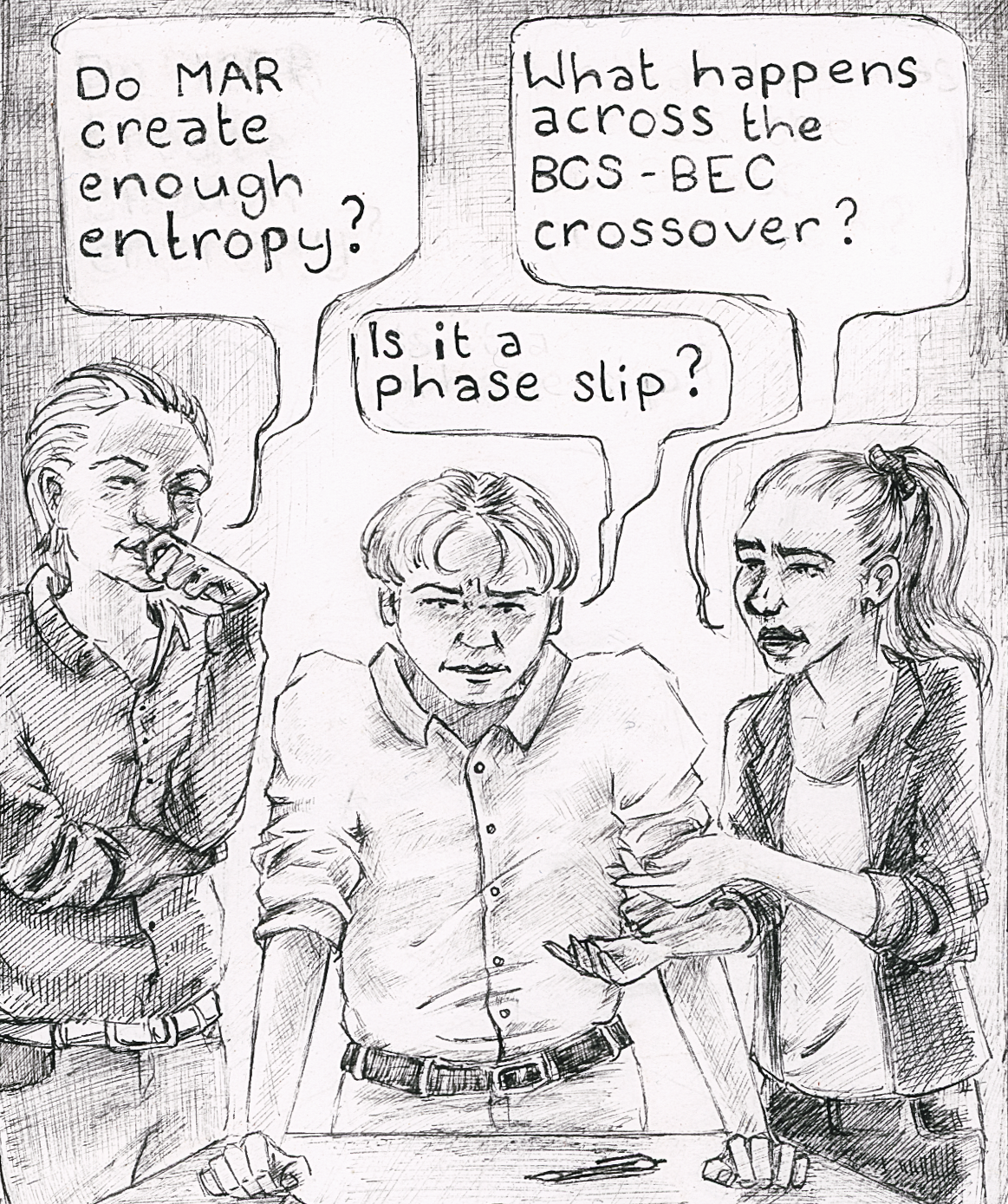Superfluid surprise
Researchers from the Institute for Quantum Electronics and the Quantum Center studied particle and entropy flows between two connected superfluid reservoirs and found unexpected evidence of irreversible and enhanced entropy transport.

Laboratory experiments carried out in the early twentieth century led to the discovery of superconductivity and superfluidity, two phenomena that have since kept busy generations of scientists. In a superfluid, atoms flow without friction and with near-zero viscosity. The first observation of superfluidity involved liquid helium-4 cooled to a temperature close to absolute zero; helium-3 later came to the fore as an unconventional superfluid offering rich ground for exploration. Today, superfluid helium is commonly used for cooling other physical systems including the superconducting magnets of the Large Hadron Collider at CERN.
Shortly after the first data on liquid helium-4 were published, physicist Fritz London suggested that the observed superfluidity could be due to Bose–Einstein condensation (BEC), a process leading many bosons to occupy a single quantum state and form a condensate. The conjecture was controversial and was followed by a period of intense theoretical work on superconductivity and superfluidity. The theory of superconductivity developed by John Bardeen, Leon N. Cooper and John R. Schrieffer (BCS) succeeded in explaining how fermions such as the electrons in a superconductor could also be found in a condensate phase by forming composite particles – pairs of fermions with opposite spins, specifically – that behave like bosons. To form such composite particles, fermions must interact with one another even though the strength of the interaction need not be large. In the weak coupling limit that encompasses conventional superconductors, the size of a fermion pair will be much larger than the interparticle spacing. By contrast, there exist fermionic superfluids where these two quantities are of the same order.
The ability to create and address ultracold gases of trapped fermionic atoms opened important experimental avenues for superfluidity. In these systems, the interaction strength between particles can be tuned with an applied magnetic field. A fermionic gas with strong interactions and a diverging scattering length – which ensures strong coupling – is called a unitary Fermi gas. In the Institute for Quantum Electronics, Dr Philipp Fabritius, Dr Jeffrey Mohan and colleagues from the Quantum Optics group of Professor Tilman Esslinger studied two superfluid unitary Fermi gases connected by a ballistic channel. Their findings, just published in Nature Physics, reveal large flows of particles and entropy through the channel. The entropy transported on average by each flowing particle is substantially larger than the value expected from the theory of superfluid hydrodynamics and doesn't depend on the channel geometry. Strikingly, the researchers conclude from the data that superfluidity increases entropy transport in their system.
What you expect is not what you get
The system considered by Fabritius and coworkers is a mixture of two hyperfine ground states of lithium-6 atoms, which are trapped magnetically and optically in all three spatial directions. This trapped cloud of atoms is then separated into two reservoirs connected by a channel with variable width. The initial state of the system is characterised by conserved total atom number and energy; imbalances in the atom number and the entropy induce biases in the chemical potential and the temperature. Particle and entropy currents can be tracked experimentally by applying the known equations of state to each reservoir at different points in time. Both particle and entropy currents were found to respond nonlinearly to chemical potential and temperature biases. The researchers recorded what happened to the system as it moved through state space. The entropy production rate was found to be strictly positive: this means that the observed particle, energy and entropy transport is irreversible and continues until the system reaches a final state, in or far from equilibrium. The team could attribute the entropy production to the intrinsically irreversible nature of the transport phenomenon, because their setup behaves like a closed system.
The experimental data collected by Fabritius and colleagues show that the entropy transported per particle is positive, and that the entropy current is proportional to the particle current. The latter is enhanced by superfluidity, thus leading to an increase in the entropy current. "In this type of quantum system, under well-defined conditions, we found ourselves in front of a surprising outcome – this is rare," says Esslinger. If the flow between the two reservoirs isn't reversible and entropy-free, one could be tempted to call into question the superfluid nature of the ultracold gas of lithium-6 atoms. This conclusion might be too strong though. For example, dissipative superconducting systems can host normal currents in the presence of superconducting order.

Open questions bring opportunities
Faced with a surprising outcome, the team developed a phenomenological model based on a formalism that captures general irreversible and non-equilibrium processes. The model successfully describes the observations, although it cannot go as far as explaining the microscopic origin of the measured entropy transported per particle. Esslinger and his group hope that their data and model will support the development of a microscopic theory for non-equilibrium phenomena in this type of superfluid system. Meanwhile, the team identified a few possible directions worth exploring. One would point towards multiple Andreev reflections (MAR), which in superconductors are known as the electron-hole reflection processes that capture, at the microscopic level, the onset of a supercurrent between two coupled superconductors (see the animation at the end of this section). An alternative direction would be to probe further the discontinuities – often referred to as phase slips – in the order parameter characterising the superfluids.
The team has already collected new data on the so-called BCS-BEC crossover as observed in the lithium-6 superfluid. Indeed, a unitary Fermi gas is "a strongly interacting many-body problem that lies just half-way between the well-understood BCS and BEC limits," wrote theorist Wilhelm Zwerger – a co-author on the paper and a long-term collaborator of the Esslinger group – in his perspective about the article that presented the equation of state for a lithium-6 ultracold gas like the one considered here. The BCS-BEC crossover describes how an interacting Fermi gas can go from the BCS state of weakly interacting pairs of fermions to the BEC of diatomic molecules.
Esslinger believes that lithium-6 offers great potential for new observations and better microscopic theories for superconducting and superfluid systems: acquiring the data presented in the paper was only possible because lithium-6 is such a robust, controllable system. "Lithium-6 is a gift of nature," says Esslinger. In this as well as in other areas of physics, experimental investigations are crucial input for theoretical advances. Studying entropy transport in superfluids could also clarify what happens in solid-state systems where there is no direct access to entropy.

Reference
Fabritius, P., Mohan, J., Talebi, M., Wili, S., Zwerger, W., Huang, M.-Z. & Esslinger, T. Irreversible entropy transport enhanced by fermionic superfluidity. Nat. Phys. (2024). external page DOI:10.1038/s41567-024-02483-3